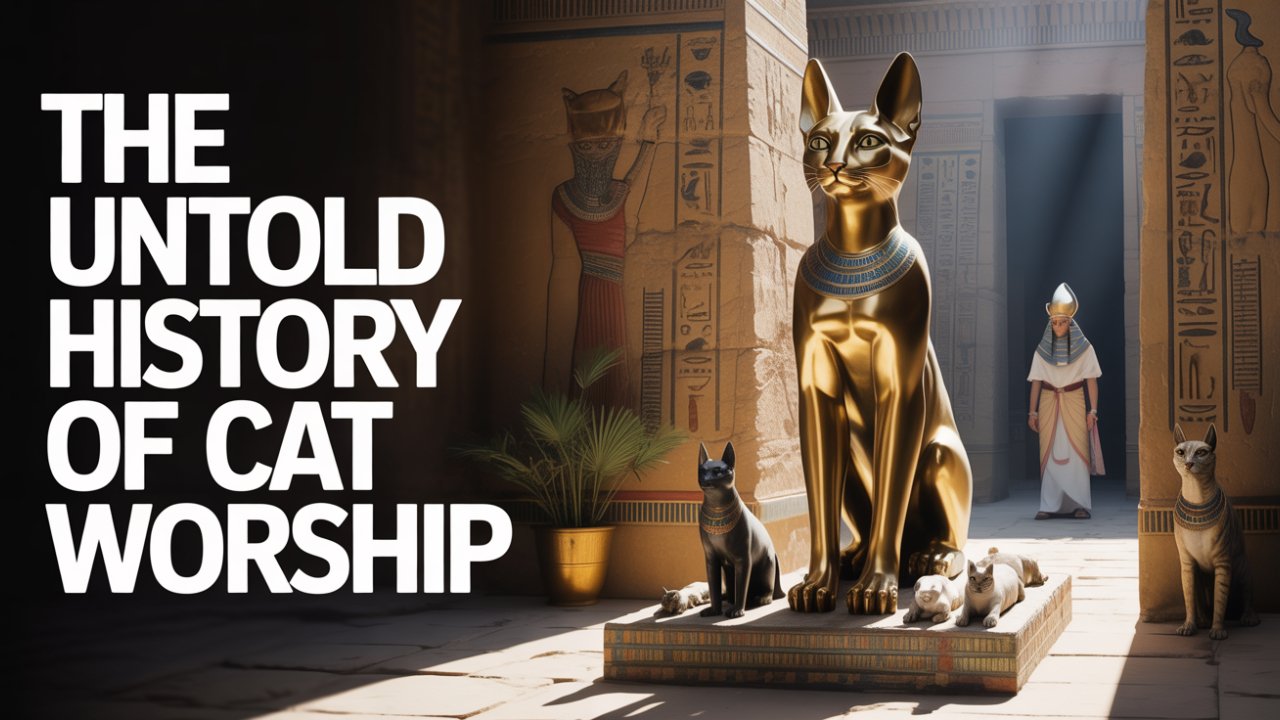We all think we know the story. In ancient Egypt, cats were practically gods. They were pampered, jeweled, and adored. When a cat died, its family mourned as if they’d lost a child, and anyone who harmed one would face terrible consequences. It’s a simple, comforting image of a world that unanimously loved our feline friends.
But what if that story is only a fraction of the truth? What if, for every pampered pet, thousands of other cats had a much darker, more brutal destiny? What if the reality for many involved being born in a temple-run breeding facility, only to be killed as a kitten and sold as a sacred offering? The true history of cat veneration in ancient Egypt isn’t a simple tale of adoration. It’s a fascinating, bizarre, and sometimes disturbing epic of gods and mortals, politics and plagues. It’s a complex relationship that elevated an animal to divine status and, in doing so, shaped both human and feline history in some truly unexpected ways. This is the untold story of how the cat became sacred, and the strange and surprising price they paid for it.
The Wild Origins
Before the pyramids pierced the sky, and long before a single cat was considered sacred, our story begins not in a grand temple, but in the dusty plains of the Fertile Crescent, some ten thousand years ago. This was the dawn of a new world. Humanity was making a monumental shift, trading the nomadic life of the hunter-gatherer for the settled life of the farmer. We were learning to grow grains like wheat and barley, and for the first time, to create a surplus of food.
This invention agriculture was the foundation of civilization. It allowed villages to become towns, and towns to become cities. It was our greatest triumph. But it also created our greatest weakness. Our precious, life-sustaining grain, stored in the first granaries, sent an open invitation to every pest for miles around. Mice and rats swarmed these new, man-made mountains of food. They were a relentless plague, threatening the very survival of these new communities. And with the rodents came other dangers: venomous snakes, like asps and vipers, slithering into homes and turning places of safety into places of fear.
Humanity was facing a crisis it had created. And into this crisis, padding silently on four paws, walked the solution. It wasn’t a human invention or a tool we forged. It was an animal: Felis silvestris lybica, the African wildcat.
This creature was a perfect predator. Solitary, stealthy, and ruthlessly efficient, it was a natural-born hunter of rodents and reptiles. For the wildcat, these new human settlements were a paradise. They weren’t drawn to us, to our fires or our company. They were drawn to the vermin we had so conveniently gathered in one place. An endless, self-replenishing buffet.
And so, one of the most significant relationships in history began not with affection, but as a pragmatic, unspoken truce. We had a pest problem. The wildcat was a pest-control expert. We didn’t need to tame them, not at first. We just needed to get out of their way. Farmers who saw these sleek hunters stalking their granaries quickly understood their value. A wildcat on the prowl meant less grain lost and fewer deadly snakes in the dark.
Slowly, a unique process of self-domestication began. The boldest cats, those less fearful of the towering, two-legged creatures, were rewarded with the best hunting grounds. They lingered, finding shelter in the nooks and crannies of human buildings. Over generations, the cats that were more tolerant of human presence thrived. They weren’t being bred by us; they were selecting themselves.
The relationship deepened. A farmer might leave out a scrap of food or a bowl of milk as a gesture of goodwill to the silent guardian of his livelihood. The wildcat, in turn, began to see the human dwelling not just as a hunting ground, but as a territory to be defended. They moved from the fields to the barns, to the very hearths of human homes. They were still wild hunters at heart, but they had entered into a compact with us.
We gave them prey and a safe place to raise their young. In return, they gave us security. They protected our food, our health, and our homes. They weren’t gods yet. They weren’t even truly pets. They were partners, indispensable allies in the struggle for survival. But here, in the practical calculus of the world’s first farmers, the seeds of their sacred status were sown. Humanity was beginning to understand that this quiet, graceful creature was more than just a hunter. It was a protector. And in the ancient world, protection was the first and most essential attribute of a god.
Egypt – The Perfect Storm
While the human-cat partnership was budding across the Fertile Crescent, it was in one particular civilization that this relationship would become something the world had never seen before. That place was Egypt.
Egypt was a civilization built by a river. The annual, predictable flooding of the Nile was its lifeblood, depositing a layer of rich, black silt that created incredibly fertile land in the middle of a desert. This allowed the Egyptians to produce massive surpluses of grain the very currency that fueled the empire. Protecting this grain wasn’t just a household chore; it was a matter of national security.
And so, the cat, already a valued partner, became a national hero in Egypt. The stakes were just higher here. A rat infestation in a small village was a problem; a rat infestation in the pharaoh’s colossal granaries was a catastrophe. The cat was the ultimate guardian of the Egyptian way of life.
But the Egyptian fascination went far beyond practicality. They were keen observers of the natural world and saw in the cat a creature of captivating duality. They watched it doting on its kittens, gentle and nurturing, a perfect image of motherhood. Then, in a flash, they’d see that same creature become a ferocious hunter, a merciless killer with eyes that burned in the twilight. This blend of gentleness and ferocity, domesticity and wildness, resonated deeply with the Egyptian worldview, which was full of dualities: order and chaos, life and death.
The cat embodied this balance perfectly. Its quiet grace, its aloof independence, and its mysterious nightlife all added to its mystique. It was a creature that shared their homes but seemed to belong to another world.
This appreciation laid the groundwork for the cat’s divine association. It wasn’t that the Egyptians worshipped cats themselves, but rather they saw cats as vessels the gods chose to inhabit. Early on, other feline gods held sway. There was Mafdet, a goddess of justice who protected against snakes and scorpions, and the terrifying lioness-headed goddess, Sekhmet, the embodiment of war and pestilence. She was the “Great Cat,” a being of immense and destructive power.
But as Egyptian society grew more stable, there was a shift in the divine landscape. The fierce, warlike protector was balanced by a desire for a guardian of the home. A remarkable transformation occurred: the goddess Bastet, who was also initially depicted as a fierce lioness, began to soften. Her lioness head slowly morphed into the head of a domestic cat. Sekhmet remained a figure of awesome power, while Bastet became the “Little Cat.”
Bastet became the goddess of the home, fertility, childbirth, and women’s secrets. She was the protector against disease and evil spirits, a role her earthly counterparts played by killing vermin. She was also the goddess of music, dance, and pleasure the joys of a secure life that the cat, in its serene contentment, seemed to represent. This was a mirror of the cat’s own journey. It had entered human society as a wild hunter, a little cousin to the lion, and had become an integral part of the family. Bastet’s transformation perfectly captured this. She was no longer just the pharaoh’s protector; she was the guardian of every family, a beloved deity whose grace could be seen in the purring companion by the fire. The cat was no longer just a partner; it was a living, breathing icon.
The Divine Feline in Egyptian Society
The elevation of the cat to the living representative of the goddess Bastet had a profound impact on Egyptian society. This wasn’t a niche belief; it was woven into their grandest myths, their most sacred rituals, and the fabric of their daily lives.
The Cat in Myth and Legend
At the heart of Egyptian cosmology was the daily struggle between the sun god Ra and his enemy, Apep, the great serpent of chaos. Every night, as Ra’s solar barge passed through the underworld, Apep would attack, seeking to devour the sun and plunge the world into eternal darkness.
The gods needed a champion to defend Ra. According to one powerful myth, the goddess Bastet, in the form of a cat, would ride alongside her father Ra. With her eyes glowing in the dark, she would fight and slay the serpent Apep, ensuring the sun could rise again.
This wasn’t just a story; it was an explanation for the cosmos. Every Egyptian who saw a housecat stalking a snake was witnessing a tiny re-enactment of this cosmic battle. Their little companion wasn’t just catching pests; it was fighting the forces of chaos. It was a guardian of ma’at the fundamental principle of order and truth. This single myth gave the species a sacred importance that’s hard for us to comprehend today.
The Cult of the Cat
This profound reverence gave rise to a massive religious cult centered around Bastet, with its epicenter in the city of Bubastis. Here, the Egyptians built a magnificent temple in her honor. The Greek historian Herodotus, who visited in the 5th century BCE, described it with awe, claiming none was more pleasing to look at.
Once a year, Bubastis hosted a spectacular festival for Bastet that drew, according to Herodotus, hundreds of thousands of pilgrims. They traveled in barges, singing, playing flutes, and celebrating. When they arrived, they would make great sacrifices and, in his words, “more wine was consumed at this festival than in all the rest of the year.” It was a time of joyous, ecstatic release, all in honor of the feline goddess.
For the average Egyptian, devotion to Bastet was a part of daily life. Amulets depicting the goddess, often with kittens at her feet, were incredibly popular, worn for protection and to invoke her blessings of fertility and safe childbirth.
But this devotion also took a larger form: the offering. Pilgrims wanted to leave a gift for the goddess to show their piety. The priests facilitated this. For a price, a devotee could purchase a bronze statue of a cat or, for a greater act of faith, pay to have a cat mummified and buried in the sacred grounds. This was believed to carry their prayers directly to the goddess.
The Mummification Industry – A Darker Side
And this is where the popular image of cat veneration begins to unravel. The demand for mummified cats as offerings became so immense that it spawned a massive, and sometimes grim, industry.
This wasn’t about mummifying beloved family pets, though that certainly happened. This was about supplying a product for a religious market. Archaeological evidence reveals the shocking scale of this operation. Vast cat cemeteries at sites like Bubastis and Saqqara contain not thousands, but millions of mummified cats. In the 19th century, one such cemetery was so enormous that its contents an estimated 180,000 mummified cats were shipped to England to be ground into fertilizer.
To meet this staggering demand, temples operated what can only be described as cat-breeding farms, raising cats specifically to be sacrificed for these votive offerings. High-resolution CT scans of these mummies have revealed the grim details. “Many appear to have been very young kittens, possibly euthanized shortly after birth as part of ancient religious rituals. It was a highly organized practice: cats were bred specifically for ritual mummification and devotional offerings.
The industry also had its frauds. Scans have revealed that a significant number of these elaborate mummies are fakes. some were found to contain only partial feline remains or filler materials such as reeds and cloth, likely due to the high demand. Pilgrims may have unknowingly purchased inauthentic offerings, a reminder that even sacred traditions were not immune to commercial pressures.
This discovery shatters the simplistic notion that every cat in Egypt was worshipped. While they were revered as a species, a vast number were treated as a commodity, bred and sacrificed on a scale that is difficult to comprehend.
If you’re finding this hidden history as fascinating as I do, take a moment to support the channel. Hitting that ‘like’ button and subscribing helps us explore more surprising stories from the past. It’s a small click for you that makes a huge difference for us. Now, back to the lives of the cats who weren’t part of this industry the ones who truly lived like royalty.
A Life of Luxury and Law
While countless cats were destined for the mummification table, many others experienced the full benefits of their species’ divine status. For a cat living as a pet in an Egyptian household, life was exceptionally good. They were treated as family members, sometimes draped in jewels and given names.
Tomb paintings show cats sitting under the chairs of their owners at grand banquets or joining them on hunting trips. The tomb of the nobleman Nebamun features a beautifully rendered cat, a clear statement that this was a beloved companion he wished to have with him for all eternity.
When these cherished pets died, the grief was profound. The historian Herodotus wrote that when a house cat died of natural causes, everyone in the house would shave their eyebrows as a sign of deep sorrow. The mourning period wasn’t over until their eyebrows grew back, a very public display of their loss.
The cat’s body was treated with a reverence usually reserved for humans. They were carefully mummified, wrapped in fine linen, and sometimes placed in elaborate sarcophagi. They were often buried with bowls of milk and even mummified mice to ensure their comfort in the afterlife.
This reverence was enshrined in law. The life of a cat was sacred, and the state strictly forbade their export. The most severe law, however, concerned the killing of a cat. The later historian Diodorus Siculus wrote that killing a cat, even accidentally, was a crime punishable by death. He described a dramatic account of a Roman official who allegedly caused a cat’s death and faced fatal consequences from a distressed crowd, despite pleas from the King and fear of angering Rome. While such ancient accounts may be embellished, they show how seriously this protection was taken.
This absolute protection led to another bizarre story from Herodotus. He claimed that if a house caught fire, the Egyptians’ first priority was to save the cats People would reportedly form a human barrier to protect the cats, prioritizing their safety during emergencies. The story illustrates a cultural priority: property was replaceable, but the life of a cat was sacred.
This status was so well-known that it was even exploited in war. During the Battle of Pelusium in 525 BCE, the invading Persian army allegedly used a brutal psychological tactic. The story goes that They allegedly used cats and sacred animal imagery as a psychological tactic, knowing the Egyptians’ deep reverence would make them hesitate. The Egyptian soldiers, horrified at the thought of harming the animals, hesitated to attack, and the Persians won a decisive victory. Though this story comes from later sources and might be apocryphal, it shows how deeply the Egyptians’ reverence for cats was perceived by their enemies.
Beyond the Nile – The Feline Diaspora
For centuries, Egypt guarded its feline treasures, but such a prized animal couldn’t be contained. The cat’s journey to the rest of the ancient world was a tale of trade and smuggling, likely with the Phoenicians, the master mariners of the ancient world, leading the way. A cat on a ship was as valuable as one in a granary, protecting cargo from rodents during long voyages.
When cats arrived in Europe, they found a different reception. In Greece and early Rome, they were seen as exotic pets but had competition from ferrets and weasels as pest controllers.
It was the Roman Empire that truly propelled the cat across the continent. The Romans were, above all, practical. As their empire expanded, their legions marched with a vast supply chain dependent on massive grain stores. The Romans quickly recognized the cat’s superior skill as a mouser and adopted it for their forts and supply depots. Roman soldiers brought cats with them wherever they went, introducing them to new lands.
As the Roman Empire absorbed different cultures, it also absorbed their beliefs. Egyptian cults became popular, and a reverence for cats traveled with them. While cats never achieved the same divine status they held in Egypt, they became powerful symbols. In Rome, the cat was associated with the idea of liberty. Its independence and self-sufficiency were seen as the embodiment of a free spirit that could not be truly tamed or owned.
This reverence evolved as it spread. It was no longer a state religion but a kind of potent folklore. From China, where a cat spirit was believed to protect crops, to Slavic folklore, which featured a demonic cat spirit called an Ovinnik that haunted barns, feline figures popped up across the globe, each reflecting a local interpretation of the cat’s mysterious power.
However, no other civilization would ever replicate the sheer scale of Egypt’s devotion. The unique combination of economic necessity, cultural appreciation, and religious mythology created a “perfect storm” on the banks of the Nile. As the cat spread, its divinity was diluted, transformed into respect, superstition, and affection. It had conquered the world, not as a god, but as an indispensable companion.
The Fall from Grace and the Enduring Legacy
The golden age of the divine feline couldn’t last forever. The conquest of Egypt by the Persians, Greeks, and finally the Romans began to erode the old ways. When Christianity became the state religion of the Roman Empire in 380 AD, the temples to Bastet were closed, and the formal, state-sanctioned veneration of cats came to an end.
As Europe entered the Middle Ages, the cat’s status underwent a terrifying reversal. In a world dominated by a new faith, the old pagan gods were demonized. The cat, with its ancient divine associations and mysterious nocturnal habits, became a target of suspicion. It was transformed in the popular imagination from a sacred vessel to a symbol of the demonic, associated with witchcraft and heresy. The same animal once protected by penalty of death was now persecuted out of fear.
And yet, the story doesn’t end there. Despite centuries of persecution, the cat endured. And that ancient reverence, buried for a thousand years, has left a permanent echo in our modern world. It’s a key part of the cat’s history that shapes our relationship with them to this day.
Think about it. We no longer worship Bastet, but the unique place cats hold in our homes is a direct legacy of their time as divine symbols. Why do we joke that we are their servants, that they are the true rulers of the household? It’s an unconscious echo of a time when they were seen as sacred.
The Egyptians saw in them a perfect balance of grace and power, nurturing love and fierce independence. We still see that today. They live in our homes, but on their own terms, retaining a captivating aura of mystery that other domesticated animals have lost. The internet’s obsession with cats is just the modern version of the festival at Bubastis, a mass celebration of a creature we find endlessly fascinating.
The ancient Egyptians believed the cat was a conduit to the divine, a guardian against the forces of chaos. Though we may have rationalized it, that sense of mystique has never truly left them. They are more than just pets. They are living history, padding silently through our homes, carrying the faint, ancestral memory of a time when they were revered on the banks of the Nile. The history of cat veneration isn’t just about the past; it’s about understanding why this remarkable animal continues to hold such a powerful, almost sacred, grip on the human imagination.
From the granaries of the Fertile Crescent to the temples of the pharaohs, from the battlefields of Persia to our living rooms, the journey of the cat is a story of survival, adaptation, and an unparalleled bond with humanity. It’s a history far stranger and more complex than we ever imagined, filled with devotion and darkness, sacred laws and ritual sacrifice.
So the next time your cat curls up on your lap or stares out the window with those inscrutable eyes, remember the epic history it carries. You are in the presence of a creature that has been a partner, a protector, a symbol of liberty, a victim of superstition, and for one glorious, complicated moment in time, a sacred vessel of the gods.
Thank you for joining us on this journey into the past. If you enjoyed uncovering this story, please hit the like button, subscribe, and ring that notification bell so you don’t miss our next historical exploration. And let us know in the comments: What’s the most god-like thing your cat does? We’d love to hear your stories. Until next time, keep digging into the past.





